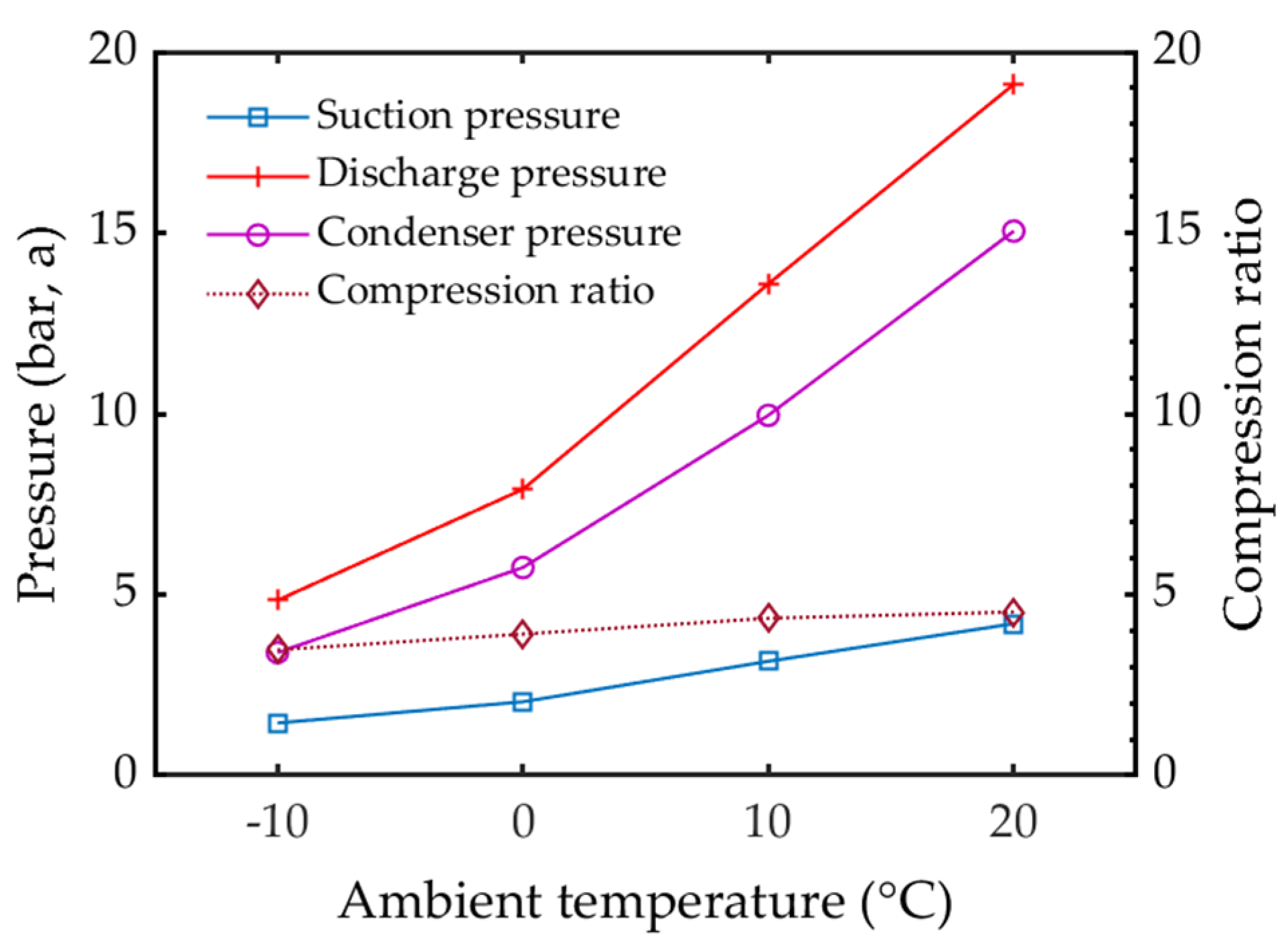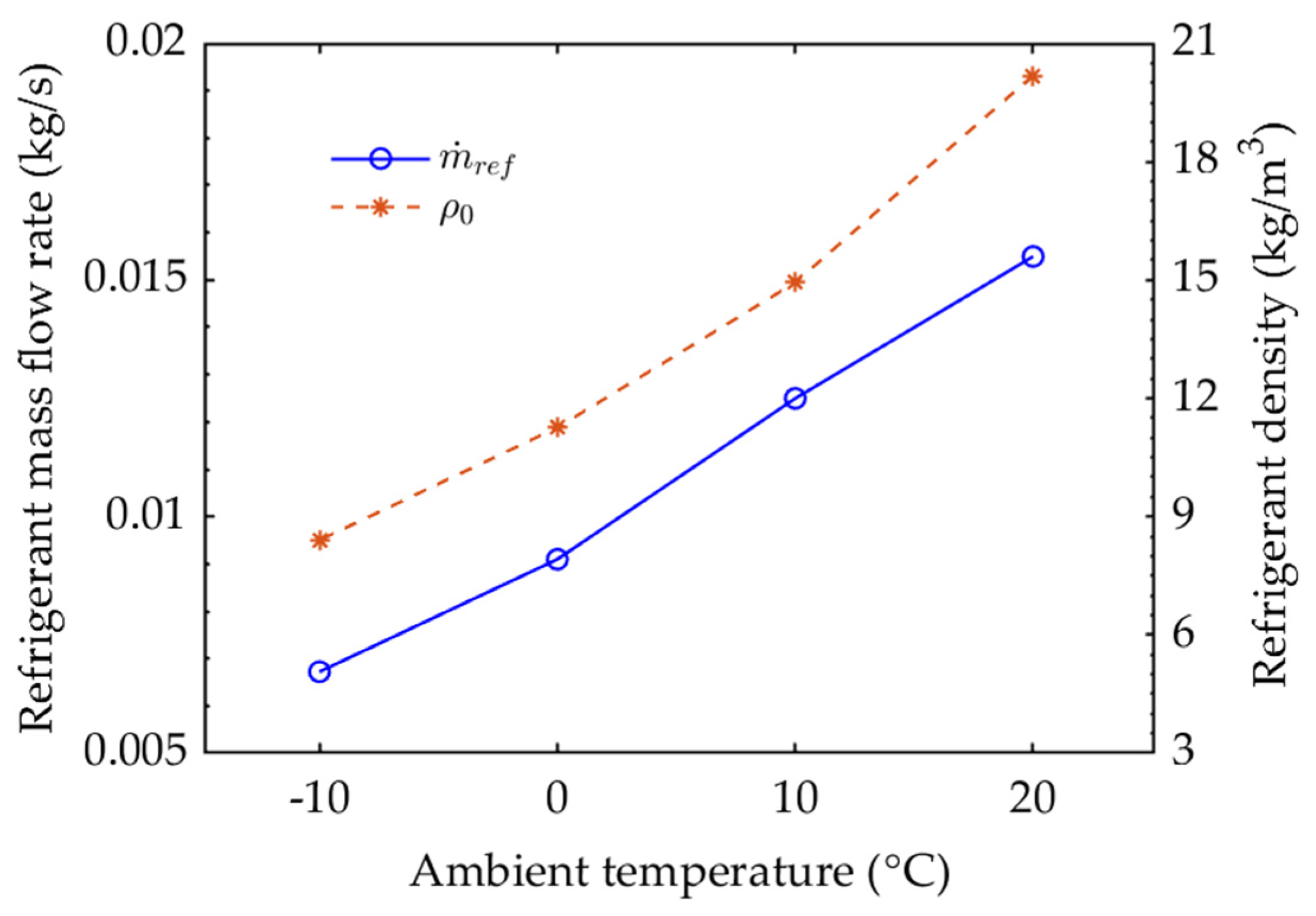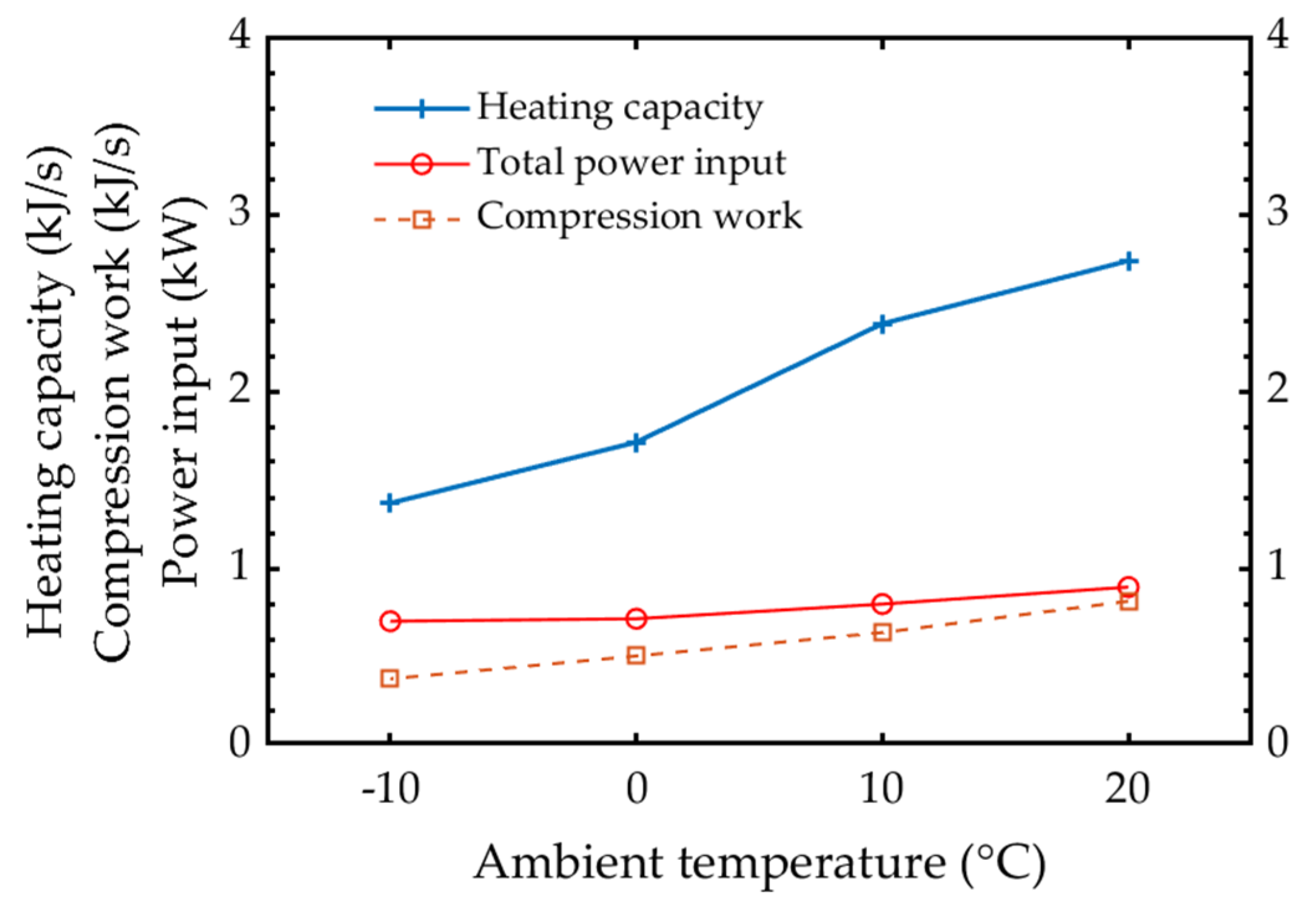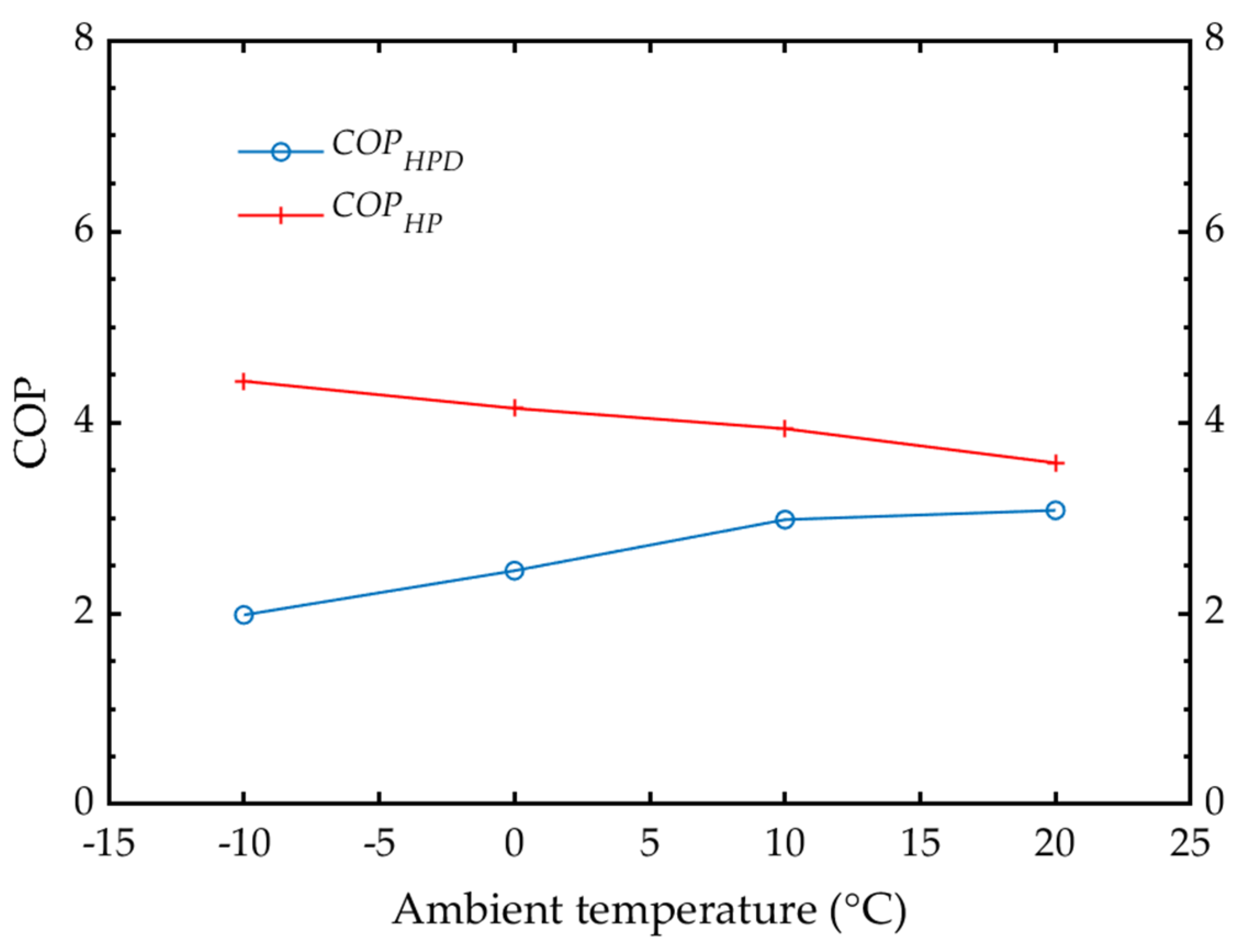Viability of an Open-Loop Heat Pump Drying System in South African Climatic Conditions †
Abstract
:1. Introduction
2. Materials and Methods
2.1. Materials and Equipment
2.1.1. Heat Pump
2.1.2. Air Duct and Drying Chamber
2.1.3. Measurement Equipment Specifications and Data Acquisition

2.2. Experimental Procedure
3. Experimentation and Uncertainty
3.1. Results and Data Analysis
3.2. Uncertainties
4. Results and Discussions
4.1. Variation in the Operating Conditions of the Open HPD System with Ambient Temperatures
4.2. Influence of Ambient Temperature on the Thermal Performance of the Heat Pump Drying System
5. Conclusions
- (i)
- Lower ambient temperatures result in diminished evaporator, suction, and discharge temperatures.
- (ii)
- These results have shown that, although the refrigerant density may generally decrease with temperature, the second property to determine the state of the refrigerant, such as the pressure, was also a significant property.
- (iii)
- The higher rate of increase in the discharge pressure with ambient temperatures compared to the suction pressure, which increased the compression ratio, negatively influenced the volumetric efficiency of the compressor.
- (iv)
- The power consumption by the compressor is highly dependent on the refrigerant mass flow rate, and the heating capacity greatly influences the COPHPD.
- (v)
- At ambient temperatures below 10 °C, the COP of the open HPD system decreased significantly, indicating the reduced energy efficiency of an open-loop air-source HPD system in such conditions.
Author Contributions
Funding
Data Availability Statement
Conflicts of Interest
Abbreviations
| ASHRAE | American Society of Heating, Refrigerating, and Air-Conditioning Engineers |
| COP | Coefficient of performance |
| EES | Engineering Equation Solver |
| HP | Heat pump |
| HPD | Heat pump dryer |
| TEV | Thermal expansion valve |
| Refrigerant mass flow rate (kg/s) | |
| h | Specific enthalpy (kJ/kg) |
| P | Power ((kJ/s) or (kW)) |
| p | Absolute pressure (bar, a) |
| Heating capacity (kJ/s) | |
| Q | Heating effect (kJ/kg) |
| t | Temperature (°C) |
| W | Work (kJ/kg) |
| Subscripts | |
| Comp | Compressor |
| Cond | Condenser |
| Evap | Evaporator |
| ref | Refrigerant |
| ρ | Density |
| Ø | Diameter |
| η | Efficiency |
References
- Ishaku, H.P.; Adun, H.; Jazayeri, M.; Kusaf, M. Decarbonisation Strategy for Renewable Energy Integration for Electrification of West African Nations: A Bottom-Up EnergyPLAN Modelling of West African Power Pool Targets. Sustainability 2022, 14, 15933. [Google Scholar] [CrossRef]
- Yousaf, K.; Chen, K.; Khan, M.A. An Introduction of Biomimetic System and Heat Pump Technology in Food Drying Industry. In Biomimetics; IntechOpen: London, UK, 2020. [Google Scholar]
- Sansaniwal, S.K.; Sharma, V.; Mathur, J. Energy and exergy analyses of various typical solar energy applications: A comprehensive review. Renew. Sustain. Energy Rev. 2018, 82, 1576–1601. [Google Scholar] [CrossRef]
- El Hage, H.; Herez, A.; Ramadan, M.; Bazzi, H.; Khaled, M. An investigation on solar drying: A review with economic and environmental assessment. Energy 2018, 157, 815–829. [Google Scholar] [CrossRef]
- Kivevele, T.; Huan, Z. A review on opportunities for the development of heat pump drying systems in South Africa. S. Afr. J. Sci. 2014, 110, 37–47. [Google Scholar] [CrossRef]
- Wang, L. Energy efficiency technologies for sustainable food processing. Energy Effic. 2014, 7, 791–810. [Google Scholar] [CrossRef]
- Shah, N.; Huang, M.; Hewitt, N.J. Performance analysis of diesel engine heat pump incorporated with heat recovery. Appl. Therm. Eng. 2016, 108, 181–191. [Google Scholar] [CrossRef]
- Chua, K.J.; Chou, S.K.; Yang, W.M. Advances in heat pump systems: A review. Appl. Energy 2010, 87, 3611–3624. [Google Scholar] [CrossRef]
- Tunckal, C.; Doymaz, İ. Performance analysis and mathematical modelling of banana slices in a heat pump drying system. Renew. Energy 2020, 150, 918–923. [Google Scholar] [CrossRef]
- Fan, H.; Shao, S.; Tian, C. Performance investigation on a multi-unit heat pump for simultaneous temperature and humidity control. Appl. Energy 2014, 113, 883–890. [Google Scholar] [CrossRef]
- Fayose, F.; Huan, Z. Heat Pump Drying of Fruits and Vegetables: Principles and Potentials for Sub-Saharan Africa. Int. J. Food Sci. 2016, 2016, 9673029. [Google Scholar] [CrossRef]
- Choi, J.M.; Kim, Y.C. The effects of improper refrigerant charge on the performance of a heat pump with an electronic expansion valve and capillary tube. Energy 2002, 27, 391–404. [Google Scholar] [CrossRef]
- Pitarch, M.; Hervas-Blasco, E.; Navarro-Peris, E.; Corberán, J.M. Exergy analysis on a heat pump working between a heat sink and a heat source of finite heat capacity rate. Int. J. Refrig. 2019, 99, 337–350. [Google Scholar] [CrossRef]
- Elsayed, A.O.; Hariri, A.S. Effect of condenser air flow on the performance of split air conditioner. In Proceedings of the World Renewable Energy Congress-Sweden, Linköping, Sweden, 8–13 May 2011; Linköping University Electronic Press: Linköping, Sweden, 2011; pp. 2134–2141. [Google Scholar]
- Sezen, K.; Gungor, A. Performance analysis of air source heat pump according to outside temperature and relative humidity with mathematical modeling. Energy Convers. Manag. 2022, 263, 115702. [Google Scholar] [CrossRef]
- Carroll, P.; Chesser, M.; Lyons, P. Air Source Heat Pumps field studies: A systematic literature review. Renew. Sustain. Energy Rev. 2020, 134, 110275. [Google Scholar] [CrossRef]
- Wu, C.; Liu, F.; Li, X.; Wang, Z.; Xu, Z.; Zhao, W.; Yang, Y.; Wu, P.; Xu, C.; Wang, Y. Low-temperature air source heat pump system for heating in severely cold area: Long-term applicability evaluation. Build. Environ. 2022, 208, 108594. [Google Scholar] [CrossRef]
- Koopman, T.; Zhu, T.; Rohlfs, W. Performance evaluation of air-source heat pump based on a pressure drop embedded model. Heliyon 2024, 10, e24634. [Google Scholar] [CrossRef] [PubMed]
- Li, X.; Wang, Y.; Li, M.; Hang, M.; Zhao, W.; Kong, D.; Yin, G. Performance testing of a heat pump system with auxiliary hot water under different ambient temperatures. Energy Built Environ. 2022, 3, 316–326. [Google Scholar] [CrossRef]
- Bagarella, G.; Lazzarin, R.; Noro, M. Sizing strategy of on–off and modulating heat pump systems based on annual energy analysis. Int. J. Refrig. 2016, 65, 183–193. [Google Scholar] [CrossRef]
- Ji, S.; Liu, Y.; Xu, H.; Yang, Y.; Chen, J.; Xue, K.; Sun, Y. Application and Analysis of Air-Source Heat Pump Heat Supply System in Cold Areas. J. Phys. Conf. Ser. 2022, 2186, 012017. [Google Scholar] [CrossRef]
- Ji, W.; Cai, J.; Ji, J.; Huang, W. Experimental study of a direct expansion solar-assisted heat pump (DX-SAHP) with finned-tube evaporator and comparison with conventional DX-SAHP. Energy Build. 2020, 207, 109632. [Google Scholar] [CrossRef]
- Hamid, K.; Sajjad, U.; Yang, K.S.; Wu, S.-K.; Wang, C.-C. Assessment of an energy efficient closed loop heat pump dryer for high moisture contents materials: An experimental investigation and AI based modelling. Energy 2022, 238, 121819. [Google Scholar] [CrossRef]
- Yu, F.W.; Chan, K.T. Advanced control of heat rejection airflow for improving the coefficient of performance of air-cooled chillers. Appl. Therm. Eng. 2006, 26, 97–110. [Google Scholar] [CrossRef]
- ANSI/ASHRAE Standard 41.1-2013; Standard Method for Temperature Measurement. ASHRA: EAtlanta, GA, USA, 2013.
- ANSI/ASHRAE Standard 41.3-2014; Standard Method for Pressure Measurement. ASHRA: EAtlanta, GA, USA, 2014.
- Ndukwu, M.C. Effect of drying temperature and drying air velocity on the drying rate and drying constant of cocoa bean. Agric. Eng. Int. CIGR J. 2009, 6. [Google Scholar]
- Ngalonkulu, S.M.; Huan, Z. The influence of ambient temperature and fan speed on the operating conditions of an open-loop heat pump drying system. In Proceedings of the International Heat Transfer Conference Digital Library, Cape Town, South Africa, 14–18 August 2023; Begel House Inc.: Danbury, CT, USA. [Google Scholar] [CrossRef]
- Prapainop, R.; Suen, K.O. Effects of refrigerant properties on refrigerant performance comparison: A review. Int. J. Eng. Res. Appl. 2012, 2, 486–493. [Google Scholar]
- Hervas-Blasco, E.; Pitarch, M.; Navarro-Peris, E.; Corberán, J.M. Study of different subcooling control strategies in order to enhance the performance of a heat pump. Int. J. Refrig. 2018, 88, 324–336. [Google Scholar] [CrossRef]
- Janković, Z.; Sieres, J.; Cerdeira, F.; Pavković, B. Analysis of the impact of different operating conditions on the performance of a reversible heat pump with domestic hot water production. Int. J. Refrig. 2018, 86, 282–291. [Google Scholar] [CrossRef]
- Prabakaran, R.; Lal, D.M.; Kim, S.C. A state of art review on future low global warming potential refrigerants and performance augmentation methods for vapour compression based mobile air conditioning system. J. Therm. Anal. Calorim. 2023, 148, 417–449. [Google Scholar] [CrossRef]
- Alishah, A.; Kiamahalleh, M.V.; Yousefi, F.; Emami, A.; Kiamahalleh, M.V. Solar-assisted heat pump drying of coriander: An experimental investigation. Int. J. Air-Cond. Refrig. 2018, 26, 1850037. [Google Scholar] [CrossRef]











Disclaimer/Publisher’s Note: The statements, opinions and data contained in all publications are solely those of the individual author(s) and contributor(s) and not of MDPI and/or the editor(s). MDPI and/or the editor(s) disclaim responsibility for any injury to people or property resulting from any ideas, methods, instructions or products referred to in the content. |
© 2024 by the authors. Licensee MDPI, Basel, Switzerland. This article is an open access article distributed under the terms and conditions of the Creative Commons Attribution (CC BY) license (https://creativecommons.org/licenses/by/4.0/).
Share and Cite
Ngalonkulu, S.M.; Huan, Z. Viability of an Open-Loop Heat Pump Drying System in South African Climatic Conditions. Energies 2024, 17, 2432. https://doi.org/10.3390/en17102432
Ngalonkulu SM, Huan Z. Viability of an Open-Loop Heat Pump Drying System in South African Climatic Conditions. Energies. 2024; 17(10):2432. https://doi.org/10.3390/en17102432
Chicago/Turabian StyleNgalonkulu, Solomzi Marco, and Zhongjie Huan. 2024. "Viability of an Open-Loop Heat Pump Drying System in South African Climatic Conditions" Energies 17, no. 10: 2432. https://doi.org/10.3390/en17102432




